|



































|
 |
 Non-Linear Systems
Non-Linear Systems
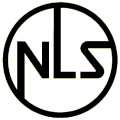 |
Steve's
NonLinear Systems
Collection
|
Welcome to my collection of vintage NLS Non-Linear Systems digital meters, computers, test equipment, and the NLS Stereo Receiver.
This site contains information about vintage NLS items in my collection manufactured
by Non-Linear Systems of San Diego, California.
Non-Linear Systems (NLS) was founded in 1952. Andrew Kay started the company in Southern California.
The following year Non-Linear Systems manufactured and sold the first digital voltmeter.
The First Digital Voltmeter
The first digital voltmeter's display was four digits and consisted of five sections. Four sections contained eleven clear plates, each
engraved with a single digit from 0 to 9 and a decimal point. The voltmeter was auto-ranging and the left most section of the
display contained clear plates with a "+" or "-" sign engraved in them to show polarity of the reading.
|
NLS - The First Digital Display
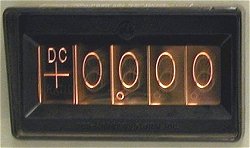
Watch Video (New window - YouTube)
The plate containing the correct digit in each section was lit by a small incandescent lamp
located at the top of the plate. This first type of digital display was known as an "edge-lit display". Display Teardown
NLS used this type of display until the mid 1960s when "nixie" vacuum tubes became the commonly used display device.
Since then NLS has been most known for it's line of panel mount digital temperature meters and voltmeters.
I do not know if NLS is still in business today (July, 2013) as they have not replied to any of my requests for documentation and they don't answer their phone.
Their web site is www.nonlinearsystems.com
|

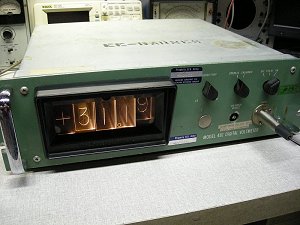 |
Non-Linear Systems Model 481
Digital Voltmeter
This early NLS 481 digital voltmeter utilizes the NLS "Edge Lit Display. The unit is rack mount and weighs in around 30 pounds.
Working examples with these early edge lit displays are not common. I usually only run across one about once or twice a year.
|

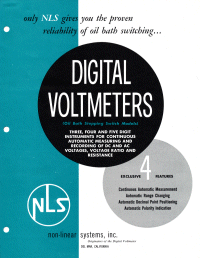 |
Non-Linear Systems Catalog
NLS five page catalog covering the NLS line of three, four, and five digit digital voltmeters with edge lit displays including specifications and accessories.
Non-Linear Systems Catalog
|

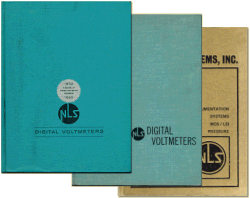 |
Non-Linear Systems Books
NLS published three hardcover books on their beginning and the theory and operation of the first digital voltmeters.
More information including History of NLS and a Photo Tour.
|

Non-Linear Systems X-2 DMM
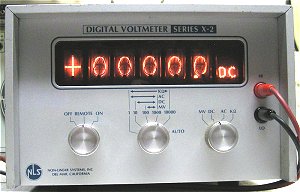
The NLS X-2 DMM was manufactured around 1967. Unlike NLS's first series of digital meters, the X-2 utilizes a newer nixie tube display.
|
The display of the X-2 is made up of seven nixie tubes with the far left nixie tube signifying + (positive) or - (negative) and the far right
nixie tube displaying AC, DC, K Ohms (ohms symbol), or MV. There were at least a couple different versions of the X-2 series. This X-2 has remote inputs and adjustable offset controls on the back but no cooling fan.
Larger Photo
Nixie Display
X-2 Back
Inside
Board Layout Diagram
Catalog Listing
Operations Manual
|

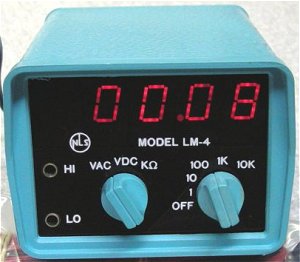 |
Non-Linear Systems LM-4 DMM
This NLS LM-4 DMM was manufactured around 1975.
The LM-4 is AC or battery powered and only 2 1/2 inches wide. It utilizes a LED (Light Emitting Diode) display.
I was surprised to find this one unused and still
in it's original box after 38 years. It is serial number 069. The meter's test leads use mini banana plugs.
Larger Photo
LED Display
Original Box
LM-4 Bottom
LM-4 Specifications Sheet
Converter/Charger # PS-8004
120VAC in / 4.8 VDC at .6 A
continuous output
|

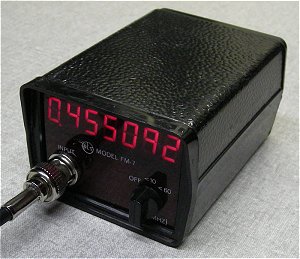 |
Non-Linear Systems FM-7 Frequency Counter
The NLS FM-7 Frequency Counter is powered by 4 AA batteries or a small AC-DC power supply. It utilizes a LED (Light Emitting Diode) display.
This is built in the same small case as the LM series meters. The chassis consists of three boards sandwiched together and slid in the case from the back. They look to be a power supply/battery compartment board, an input/control board, and a display board.
Larger Photo
Inside
FM-7 Instructions (PDF file)
|

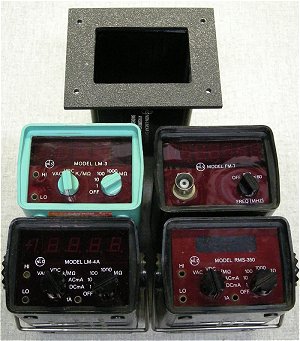 |
Non-Linear Systems LM Series Cases
At least three case styles were offered in this series. The standard case (middle) a tilt stand case (bottom) and a panel mount case (top).
Pictured at left are the LM-3 DMM, FM-7 Frequency Counter, LM-4A DMM and RMS-350 LCD display DMM.
Larger Photo
|

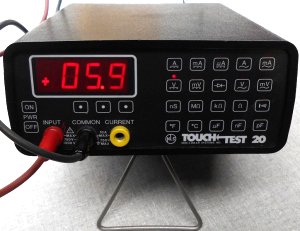 |
Non-Linear Systems
Touch Test 20 DMM
The NLS Touch Test 20 came in two versions, an AC powered model TT-20 and an AC/Battery version model TT-20B.
It measured AC, DC, Current, Temperature, and Capacitance with a 3½ digit LED display.
The DMM measures 6 1/4" x 2 5/8" x 8" deep and is a perfect companion to the NLS Miniscope below.
Larger Photo - Front
Larger Photo - Back
Larger Photo - Chassis
|

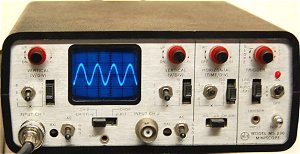 |
Non-Linear Systems MS-230 Miniscope
The NLS MS-230 Miniscope was manufactured in the late 1970s. It is a two channel 30 MHz portable oscilloscope powered by an AC/charger or internal rechargeable batteries.
Inputs will handle up to 450 volts. Carry case with strap holds the miniscope, charger, and probes.
The miniscope measures 6 1/4" x 2 5/8" x 8" deep.
Larger Photo
Inside
Carry Case
|

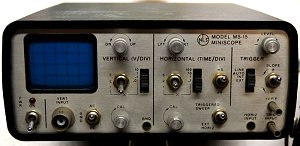 |
Non-Linear Systems MS-15 Miniscope
The NLS MS-15 Miniscope is a single channel 15 MHz portable oscilloscope powered by an AC/charger or internal rechargeable batteries.
Input will handle up to 350 volts. Carry case with strap holds the miniscope, charger, and probes.
The miniscope measures 6 1/4" x 2 5/8" x 8" deep and is the same physical size as the MS-230 Miniscope and the Touch Test 20 DMM above.
Larger Photo
With Carry Case
|

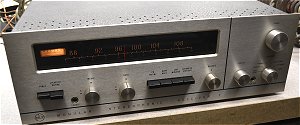
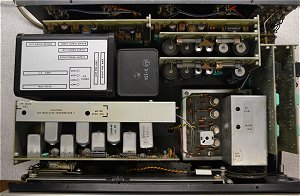
|
NLS Modular Stereophonic Receiver I
Non-Linear Systems also manufactured a FM stereo receiver. I have only seen a couple and have found little information on it so I think their venture into consumer audio was short lived.
The NLS receiver lives up to it's name as a "Modular" receiver. As you can see from the chassis photo, it's built like a quality piece of test
equipment with every circuit section on it's own removable board.
Larger Photo
Photo - Chassis
Photo - Rear
|

Kaypro II
by Non-Linear Systems
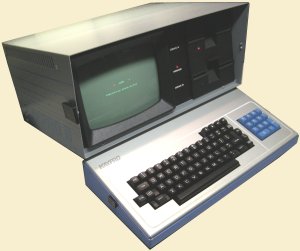 The Kaypro II Portable Computer.
The Kaypro II Portable Computer.
|
In 1982 Non-Linear Systems (NLS) produced the first Kaypro computer.
This venture unlike their stereo receiver became very popular.
The Kaypro II had a Z-80 microprocessor and ran the CP/M operating system. It had a large 9 inch screen with two 5¼ floppy drives. It was housed in a metal case with a carrying handle and
like the Osborne I portable, the keyboard doubled as the cover. The Kaypro II cost $1,795 and came bundled with a large selection of software including CP/M, word processing and a spread sheet programs.
In 1983 The Kaypro computer division was split away from NLS and Kaypro Corporation was formed to manufacture Kaypro computers.
Note that the Kaypro II manufactured under the Non-Linear Systems name was the first Kaypro model. The Kaypro 1 however, was the last model produced by Kaypro almost ten years later.
Kaypro's insistence on staying with the CP/M operating system and not moving on to DOS and re-releasing reconfigured old models were major factors in their demise.
|

|
|



